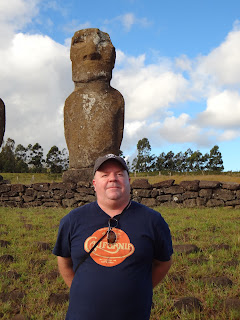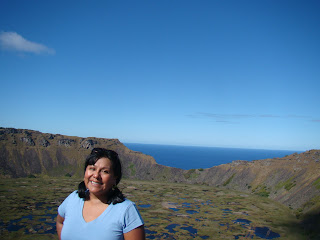One Last South American Adventure-Easter Island

Greetings folks,
Time is ticking quickly on our residence in the Western Hemisphere; by the end of this month, we will be calling Dhaka, Bangladesh home for at least two years and this blog is certain to take a very interesting turn.
Before embarking on that grand adventure, we were able to slip in an extraordinary visit when we recently jetted into the South Pacific to Easter Island. I'll be honest-when Marianella and I first moved to Peru and were playing the game of "where do we want to travel?", neither of us had Easter Island very high on the list. It seemed remote, we figured it would be expensive and outside of some giant stone statues, we wondered what the allure would be. After this trip, we have both recanted our foolish initial thoughts about the island.
It is certainly remote-in fact, it stakes the claim as the most remote inhabited place on Earth, with its nearest neighbors being Chile to the east (roughly 2300 miles) and Tahiti to the west (2500 miles) and no one closer except perhaps Robinson Crusoe floating on a raft. We spent our time on the island marveling how it was ever found in the first place, much less made home. It is a speck on an island, with access to each coast a short drive away. The island was formed when three volcanoes emerged out of the sea and morphed together eons ago. Those volcanoes are now dormant, but the remains are omnipresent-volcanic rocks dot the land, while craters of various sizes create an undulating topography across the land. Underneath the surface are caves carved by the molten lava that once spewed into the vast Pacific. Supposedly when the initial settlers arrived in approximately 1200 A.D., the island was lush and fertile, but as the population increased, the vegetation quickly became depleted and the people discovered that attempting to subside on land covered by volcanic rock was pretty daunting. Scrapping for survival, warfare ensued and a population that is estimated to have peaked around 50,000 people rapidly declined. When Dutch explorers arrived in 1722 (on Easter Sunday, hence the name of the island) they found an island featuring numerous Moui (pronounced moo-eye) statues and little else. Today roughly 5000 people reside on the island, tucked into the southeast corner with the rest of the island inhabited only by the Mouis.
The Mouis are undoubtedly the rock stars of the island and what immediately comes to mind when one plays the word association game with Easter Island. I expected to be impressed by the statues, but I found myself overwhelmed by the countless giants that were found throughout the island. Our trip to the quarry, where all of the statues were carved out of the rocky hillside, was probably my favorite aspect of the tours. In this area we viewed several statues as the archeologists originally found them (they dug them out of the ground to inspect them and then placed them back into the earth) along with an unfinished giant that will remain sleeping for eternity. As you can see in the pictures, many more Mouis made it out of the quarry and are on display while others lay in ruins throughout the island-some as a result of the long-distant warfare, when rival clans would provoke their adversaries by destroying the statue that rose above their homestead. Others merely were abandoned because they were mishandled and dropped in the transfer from the quarry to their intended destination-it was deemed bad fortune to attempt to recover such a statue, so it was left as common litter on the landscape.
Near the quarry:

The sleeping, unfinished giant:

Quite the imposing fellow:

Doing my best Moui impression:

The Fab Fifteen:

Marianella being cute:

While the Mouis definitely are the headliners, there are other fascinating aspects of the island. I mentioned earlier the craters and caves etched by the formative volcanoes. From a distance Marianella and I admired the craters, but we were able to explore the caves-three of them, the only ones among many on the island deemed safe enough to maneuver in and around. Our favorite cave led out to the face of sea cliffs, several hundred feet above the surface where the violent crashing of the waves against the rock resonated visually and audibly. In some prehistoric time, lava gushed from the opening we peered out of, jetting into the ocean.

Gazing out to the Pacific through the mouth of a cave:

Sunscreen and the dark cave/camera flash conspire to make me look ghostly:

When not meeting the Mouis or crawling through caves, how did we spend our time? Blissfully relaxing, strolling around the small town that we walked the perimeter of twice, admiring the waves crashing into the rocks during the daytime, gazing at the incredible array of stars at night. Heading out to the very edge of town, we found a restaurant of reasonable price that served sublime fish and seafood along with cold beer. Polynesian music was heard everywhere we went and to our good fortune the sun shone every day. We fed the hens and roosters that are only rivaled in number by the communal dogs who seem to belong to anyone and everyone on the island. We slept in, took naps, and went to bed early after evenings spent playing cribbage. No cell phones, no TV, no clocks, and no idea what was occurring in the larger world. As I type these words, I find myself wondering how soon can we return.
Befriending the chickens:

Our goodbye gift to Easter Island:




Comments